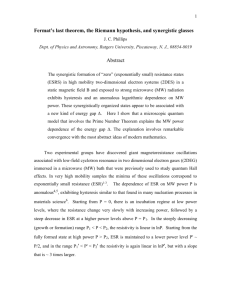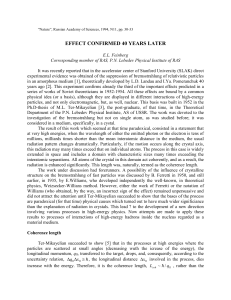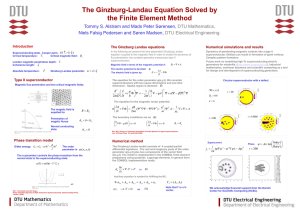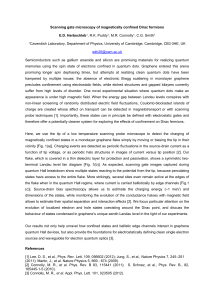EDMUND LANDAU Edmund Landau, an honorary member of this
advertisement
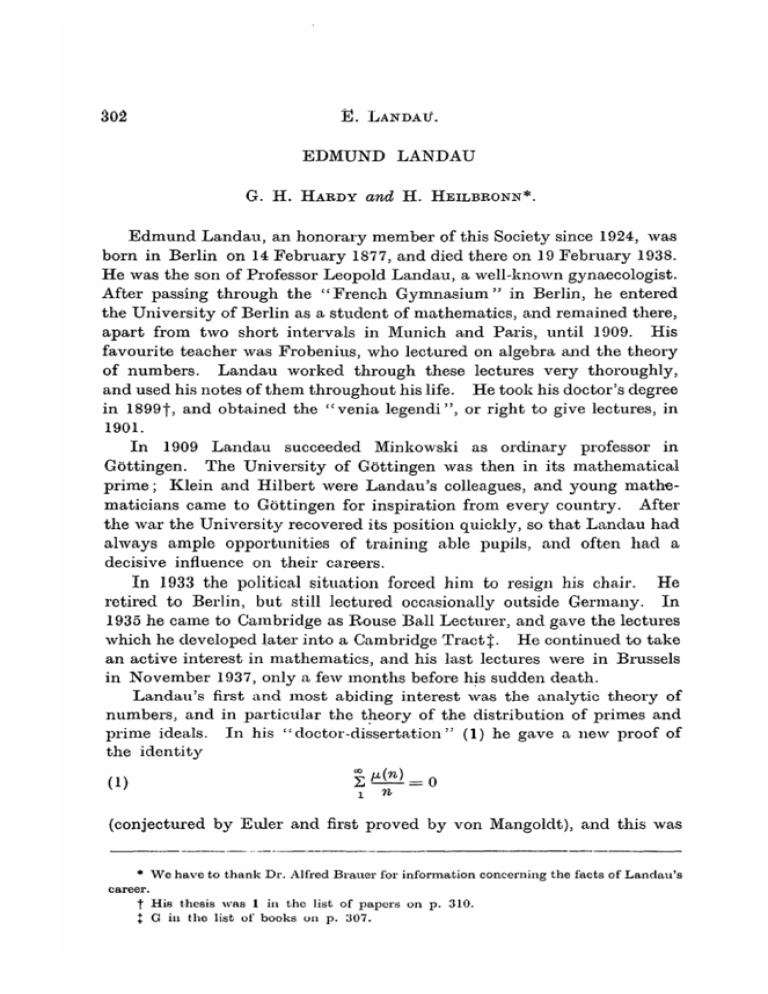
302
E. LANDAX/.
EDMUND LANDAU
G. H. HARDY and H. HEILBRONN*.
Edmund Landau, an honorary member of this Society since 1924, was
born in Berlin on 14 February 1877, and died there on 19 February 1938.
He was the son of Professor Leopold Landau, a well-known gynaecologist.
After passing through the "French Gymnasium" in Berlin, he entered
the University of Berlin as a student of mathematics, and remained there,
apart from two short intervals in Munich and Paris, until 1909. His
favourite teacher was Frobenius, who lectured on algebra and the theory
of numbers. Landau worked through these lectures very thoroughly,
and used his notes of them throughout his life. He took his doctor's degree
in 1899|, and obtained the "venia legendi", or right to give lectures, in
1901.
In 1909 Landau succeeded Minkowski as ordinary professor in
Gottingen. The University of Gottingen was then in its mathematical
prime; Klein and Hilbert were Landau's colleagues, and young mathematicians came to Gottingen for inspiration from every country. After
the war the University recovered its position quickly, so that Landau had
always ample opportunities of training able pupils, and often had a
decisive influence on their careers.
In 1933 the political situation forced him to resign his chair. He
retired to Berlin, but still lectured occasionally outside Germany. In
1935 he came to Cambridge as Rouse Ball Lecturer, and gave the lectures
which he developed later into a Cambridge Tract J. He continued to take
an active interest in mathematics, and his last lectures were in Brussels
in November 1937, only a few months before his sudden death.
Landau's first and most abiding interest was the analytic theory of
numbers, and in particular the theory of the distribution of primes and
prime ideals. In his "doctor-dissertation" (1) he gave a new proof of
the identity
(1)
n
(conjectured by Euler and first proved by von Mangoldt), and this was
* We have to thank Dr. Alfred Brauer for information concerning the facts of Landau's
career.
f His thesis was 1 in the list of papers on p. 310.
J G in the list of books on p. 307.
E.
LANDATJ.
303
the first of a long series of papers on the zeta-function and the theory of
primes.
The "prime number theorem"
was first proved by Hadamard and de la Vallee-Poussin in 1896. De la
Vallee-Poussin went further, and proved that
(3)
TT(X) = ['',— + 0{xcrA>/(k)g:(:)} = \ix+O{xe-A w°**>},
for a certain positive A. The proofs of both Hadamard and de la ValleePoussin depended upon Hadamard's theory of integral functions, and in
particular on the fact that £(s), apart from a simple pole at s = 1, is regular
all over the complex plane.
In 1903 Landau found (in 2) a new proof of the prime number theorem
which does not depend upon the general theory of Hadamard. For this
proof we need know only that £(s) can be continued " a little way over"
the line a = 1; we do not need the functional equation, the Weierstrass
product, and the other machinery used in the earlier proofs. On the other
hand we do not obtain quite so precise a formula as (3).
This discovery of Landau's was very important, since it permitted
a decisive step in the theory of the prime ideals of an algebraic field K.
This theory depends upon the properties of the Dedekind zeta-function
(4)
CAs) ^°>-"
(Na)°'
where a runs through the integer ideals of K (except 0), and Na is the norm
of a. It was not proved until much later (by Hecke in 1917) that t,K(s) can
be continued all over the plane, but Landau had no difficulty in showing
that it has properties like those of £(s) used in his proof of the prime number
theorem. He thus obtained the 'prime ideal theorem": if iiK(x) is the
number of prime ideals of K whose norm is less than x, then
(5)
ITK(X).
log a;'
Later*, using Hecke\s discoveries, he proved the formula for
corresponding to (3).
* <J, §20.
TTK(X)
304
E.
LANDAU.
The logic of prime number theory has developed a good deal since 1903
and even since 1917, and Landau kept fully in touch with all these developments. Thus his paper 12 contains the shortest and most direct proof of
the prime number theorem known today (a proof based on the ideas of
Wiener). He was also intensely interested in the logical relations between
different propositions in the theory. Thus he first proved (in 6 and 10)
that (1) and (2) are "equivalent", that each can be deduced from the
other by "elementary" reasoning, although there is no "elementary"
proof of either*. It was Landau who first enabled experts to classify
the theorems of prime number theory according to their "depths".
Landau's second big discovery Avas in an entirely different direction.
Picard's theorem states that an integral function, not a constant, assumes
all values with at most one exception. Picard. deduced his theorem in
1879 from the properties of the "modular function", and it was not until
1896 that Bore! found the first elementary proof.
In 1004 Landau, studying Borel's proof, made a most important, and
then very unexpected, extension (3). If a0 and ax are given, c/.j ^ 0, and
is regular at the origin, then there is a number LI = Ll(a(), aA) > 0, depending on «0 and a1 only, such that/(a), if regular in the circle \x\ < Q, must
assume one of the values 0 and 1 somewhere in the circle. It is obvious
that this theorem includes Picard's theorem.
A few weeks later Schottky developed Landau's theorem further.
Suppose that ao^O., aQ^l, and 0 < # < l . Then there is a number
(I) = (]>(tf0, &) with the following property: if f(x) is regular, and never
0 or 1, for j:u| < 1, and/(0) = «•„, then
for \x\ < #. Landau's theorem is a simple corollary"j\
Schottky:s theorem was imperfect in one important respect, since his
function <J> was unbounded near ao = O and aQ=l. Landau, in 13.
* T h e proof t h a t (*J) implies (I) is given in A, § 10(5, b u t t h a t of the converse implication is later.
f Sec J3 (oil. ii). p. 10,5.
E. LANDAU.
305
removed this imperfection. Suppose that a > 0 , 0 < # < 1. Then there
is a number Y = T(a, #) with the property: if /(re) is regular, and never
0 or 1, for |*| < 1, and |/(0)| <<x, then
for | re | < # . In 13 he makes an important application to the theory of
Us) and Us).
These theorems have inspired a great amount of later work.
Carathcodory, for example, found the "best" Q in terms of the modular
function. The elementary proofs have also been transformed by the
discovery of "Bloch's theorem :! , and are developed in this way in the
second edition of Landau's Ergebnisse (B).
This theorem and the prime ideal theorem were probably the most
striking of Landau's original discoveries. We state a few more with the
minimum of comment.
(1) Every large positive integer is a sum of at most 8 positive integral
cubes (9).
This 8 is the only number which has resisted the later analytic attacks
on Waring's problem.
(2) Every positive definite polynomial with rational coefficients can be
represented as a sum of 8 squares of polynomials with rational coefficients.
In particular, every positive definite quadratic with rational coefficients
is a sum of 5 squares of rational linear functions; and 5 is the best possible
number (5).
Mordell has since proved the corresponding theorem for quadratics
with integral coefficients.
(3) If /(re) ~ re when rc->-oo, and xj'(x) increases with x, then/'(re)-> 1
(8, 218).
This theorem (which contains the kernel of a differencing process used
by de la Vallee-Poussin and others in the analytic theory of numbers) is,
perhaps, the first genuine example of a " O-Tauberian" theorem.
(4) If/(re) = ao-\-a1x-\-a2x2~\-... is regular, and |/(re)| < 1, for |re| < 13
then
1\2 . /1.3\a .
, /1.3...2n—1\ 2
2) +{2A> + - + ( 2A...2n ) • •
There is equality, for every n, with an appropriate f(x) depending on n (11).
JOX7K. 52
X
306
E. LANDAU.
(5) A Dirichlet's series 'Lane~XuS, with non-negative coefficients, has
a singularity at the real point of its line of convergence (4).
This had been proved before for power-series by Vivanti and Pringsheim,
but their method of proof cannot be extended to the general case.
(6) If N(a0, T) is the number of zeros of £(s) in the domain
<J>°o>h \t\ <T, then
This was proved, first with 0 and then as stated, by Bohr and Landau
in their joint papers 14 and 15. It is known that N (£, T) is of order T log T,
so that most of the zeros of £(<s) lie very near a = \. This was the first
successful attempt to show that the Riemann hypothesis is at any rate
"approximately " true. Carlson proved later that o{T) may be replaced
by O(Ta), where 0 < a < l , and Titchmarsh and Ingham have since
improved Carlson's value of a.
Landau also published a very large number of new, shorter, and simpler
proofs of known theorems. We mention only his well-known proof of
Weierstrass's approximation Theorem (7). This depends upon the
singular integral
{{-{u-x)*}''f{u)du,
and was perhaps the first proof in which the approximating functions are
"visibly" polynomials. It is reproduced, in a more general form, in
Hobson's book (vol. ii, ed. 2, 459-461).
Landau wrote over 250 papers, but it is possible that he will b,e remembered first for his books, of which he wrote seven.
A. Handbuch der Lehre von der Verltilung der Primzahlen (Leipzig and
Berlin, Teubner, 1909: 2 vols., 961 pp.).
B. Darslcllung and Bcgrundung einiger neucrer Ergcbni-sse der Funklionentheoric (Berlin, Springer. 1910; second edition, 1929: 122 pp.).
('.. Binfulwung in die elevieiUare und analyl/iache Tlicoric. der alycbhiischcn
Zahlen und l.drale (Leipzig and Berlin.. Tcubncr, 1018; second edition,
1927: 147 pp.).
E. LANDAU.
307
D. Vorlesungen uber Zahlentheorie (Leipzig, Hirzel, 1927: 3 vols.,
1009 pp.).
E. Grundlagen der Analysis (Leipzig, Akademische Verlagsgesellschaft,
1930: 134 pp.).
F. Einfilhrung in die Dijferentialrechnung und Integralrechnung (Groningen, Noordhoff, 1934: 368 pp.).
G. Uber einige neuere Fortschritte der additiven Zahlentheorie (Cambridge
Tracts in Mathematics, No. 353 1937: 94 pp.).
i
Of these books, E and F are elementary, and we say nothing about
them, interesting and individual as they are. All the rest are works of
first-ratb importance and high distinction.
Landau was the complete master of a most individual style, which it
is easy to caricature (as some of his pupils sometimes did in an amusing
way*), but whose merits are rare indeed. It has two variations, the "old
Landau' style", best illustrated by the Handbuch, which sweeps on
majestically without regard to space, and the "new Landau style" of his
post-war days, in which there is an incessant striving for compression.
Each of these styles is a model of its kind. There are no mistakes—for
Landau took endless trouble, and was one of the most accurate thinkers
of his d \y—no ambiguities, and no omissions; the reader has no skeletons
t o fill, but is given every detail of every proof. He may, indeed, sometimes
wish that a little more had been left to his imagination, since half the truth
is often easier to picture vividly than the whole of it, and the very completeness of Landau's presentation sometimes makes it difficult to grasp the
"main idea". But Landau would not, or could not, think or write
vaguely, and a reader has to read as precisely and conscientiously as
Landau wrote. If he will do so, and if he will then compare Landau's
discussion of a theorem with those of other writers, he will be astonished
to find how often Landau has given him the shortest, the simplest, and
in the long run the most illuminating proof.
The Handbuch was probably the most important book he wrote. In
it the analytic theory of numbers is presented for the first time, not as a
collection of a few beautiful scattered theorems, but as a systematic science.
The book transformed the subject, hitherto the hunting ground of a few
* For oxample in a mock Festschrift written on the occasion of his declining an invitation to leave Gottingen for another university.
x2
308
E. LANDAU.
adventurous heroes, into one of the most fruitful fields of research of the
last thirty years. Almost everything in it has been superseded, and that
is the greatest tribute to the book.
Landau would not publish a second edition of the Handbuch (which
must necessarily have been a new book), but preferred to incorporate the
results of later researches in his Vorlesungen, which is no doubt his greatest
book. This remarkable work is complete in itself; he does not assume
(as he had done in the Handbuch) even a little knowledge of numbertheory or algebra. It stretches from the very beginning to the limits of
knowledge, in 1927, of the "additive", "analytic :) , and ''geometric"
theories. Thus part 6 (vol. i, pp. 235-269) carries the solution of Waring's
problem to where it stood before Vinogradov's recent work. Part 12
(vol. iii, pp. 201-328) contains practically everything then known about
"Fermat's last theorem ", and the rest of the book is conceived on the same
scale. In spite of this enormous programme, Landau never deviates an
inch from his ideal of absolute completeness. For example, he never
refers to his Algebraische Zahlen, but proves from the beginning everything
he needs.
The richness of content of the book, and the power of condensation
it shows, are astonishing. Thus the classical theorems about decompositions into two, three, and four squares are proved in twenty-eight
pages (vol. i, pp. 97-125). And Landau can find room (vol.i, pp. 153-171)
for four different evaluations of Gauss's sums.
The Vorlesungen is not only Landau's finest book but also, in spite of
the great difficulty and complexity of some of the subject matter, the most
agreeably written. The style here is the rather informal style of his
lectures, which he was persuaded by his friends to leave unchanged.
The Algebraische Zahlen gives a short and self-contained account
(pp. 1-54) of the theory of algebraic numbers and ideals, intended as an
introduction to the proofs of the prime ideal theorem and its refinements
which occupy the remainder of the book. He does not go so deeply into
the algebraic theory as, for example.. Heckc. being content with what is
required for his applications.
The Ergebnisse is probably Landau's most beautiful book. It contains
a collection of elegant, significant, and entertaining theorems of modern
function theory: Hadamard's and Fabjy's "gap theorems", Fatou's
theorem, the moat striking "Taubcrian " theorems, 13loch's theorem, the
Picard-Landau group of theorems, and the fundamental theorems concerning "schlicht" functions. It is one of the most attractive little
volumes in recent mathematical literature, and the most effective answer
to any one who suggests that Landau's mathematics was dull.
E. LANDAU.
30?
Finally, his last work, the Cambridge Tract originating from his
Rouse Ball lecture, gives an account of Vinogradov's " Waring" and
Schnirelmami's "Goldbach" theorems, and of a group of half solved
"elementary" problems of additive number theory which open a new
field of research for young and unprejudiced mathematicians. There is
a review of this tract by Mr. Ingham in the current volume of the
Mathematical Gazette, to which we should have little to add.
Landau was certainly one of the hardest workers of our times. His
working day often began at 7 a.m. and continued, with short intervals,
until midnight. He loved lecturing, more perhaps even than he realized
himself; and a lecture from Landau was a very serious thing, since he
expected his students to work in the spirit in which he worked himself, and
would never tolerate the tiniest rough end or the slightest compromise
with the truth. His enforced retirement must have been a terrible blow
to him; it was quite pathetic to see his delight when he found himself again
in front of a blackboard in Cambridge, and his sorrow when his
opportunity came to an end.
No one was ever more passionately devoted to mathematics than
Landau, and there was something rather surprisingly impersonal, in a man
of such strong personality, in his devotion. Everybody prefers to do
things himself, and Landau was no exception; but most of us are at bottom
a little jealous of progress by others, while Landau seemed singularly free
from such unworthy emotions. He would insist on his own rights, even
a little pedantically, but he would insist in the same spirit and with the
same rigour on the rights of others.
This was all part of his passion for order in the world of mathematics.
He could not stand untidiness in his chosen territory, blunders, obscurity,
or vagueness, unproved assertions or half substantiated claims. If X
had proved something, it was up to X to print his proof, and until that
happened the something was nothing to Landau. And the man who did
his job incompetently, who spoilt Landau's world, received no mercy;
that was the unpardonable sin in Landau's eyes, to make a mathematical
mess where there had been order before.
Landau received many honours in his lifetime. He was a member of
the Academies of Berlin, Gottingen, Halle, Leningrad, and Rome; but no
honour seemed to please him quite so much as his election to honorary
membership of this society, and he came specially from Germany to attend
our sixtieth anniversary dinner. This was natural, since there was no
country where his reputation stood quite so high as in England, and none
where his work has borne more fruit.
310
E. LANDAU.
References.
[This list contains only papers referred to in the notice.]
1. " Neuer Beweis dor Gloichung 2yu(n)/n = 0 ", Inaugural-Dissertation (Berlin, 1899).
2. " Nouer Beweis des Primzahlsatzes und Beweis des Primidealsatzes ", Math. Annalen,
56 (1903), 645-070.
3. " tiber eine Verallgemeinerung des Picardschen Satzes", Berliner Sitzungsberichte
(1904), 1118-1133.
4. " Uber einen Satz von Tschebyschef ", Math. Annalen, 01 (1905), 527-550.
6. " Uber die Darstellung definiter Funktionen durch Quadrate ", Math. Annalen, 62
(1906), 272-285.
6. " Uber den Zusammenhang einiger neuerer Siltze der analytischen Zahlentheorie",
Wiener Sitzungsberichte, 115, 2a (1906), 589-632.
7. " Uber die Approximation einer stetigen Funktion durch eine ganze rationale Funktion ".
Rend, di Palermo, 25 (1908), 337-345.
8. "Beitrage zur analytischen Zahlentheorie", Rend, di Palermo, 26 (1908), 169-302.
9. " Uber eino Anwendung der Primzahltheorie auf das Waringsche Problem in der
elementaren Zahlentheorie", Math. Annalen, 66 (1909), 102-105.
10. " Uber die Aquivalenz zweier Hauptsatze der analytischen Zahlentheorie ", Wiener
Sitzungsberichte, 120, 2a (1911), 973-988.
11. " Abschatzung der Koeffizientensumme einer Potenzreihe ", Archiv d. Math. u. Phys,
(3), 24 (1916), 250-260.
12. " Uber den Wienerschen neuen Weg zum Primzahlsatz. ", Berliner Sitzungsberichte
(1932), 514-521.
With Harald Bohr.
13. " Uber das Vcrhalten von £(s) u n f l C(s) m der Nahe der Geraden tr = 1 ", Gottinger
Nachrichten (1910), 303-330.
14. " Ein Satz iiber Diric-hletsche Reihen mit Anwendungcn auf die £-Funktion und die
Z-Funktionen ", Rend, di Palermo, 37 (1914), 2G9-272.
15. " Sur les zeros do la fonction f(.s) de Riemann ", Comptes rendus, 158 (1914), 106-110.
LOUIS NAPOLEON GEORGE FILON
G. B. JEFFERY.
Louis Napoleon George Filon was born in France on 22 November,
1875. He was the son of Augustin Filon, the French litterateur who was
tutor to the Prince Imperial. His parents came to England when he
was about three years old and lived at Margate. At this time his father
was blind and his mother in delicate health, ,so that the boy was brought
up in a serious atmosphere; an only child of invalid parents.
His father undertook his early education which centred mainly round
the Classics. He began Latin and Greek before he was six. His own
memories of this time were of regular Latin essays on Roman History



